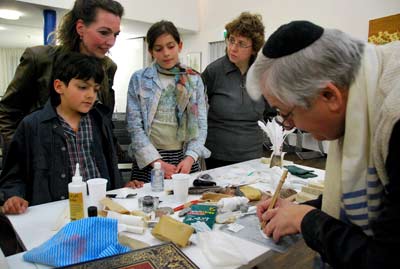The Art of Writing Torah

New York Scholar in Residence Neil Yerman is Guest in the Hamelin Reform Synagogue.

By Wolfhard Truchseß, Deister-und-Weser-Zeitung, May 20, 2014
Hamelin—His tools are reeds, turkey feathers, sponges, hand-made ink, scalpels, prepared parchment from kosher animals and a myriad of utensils. The New York City–based sofer (scribe) Neil Yerman worked
 |

Visitors watch intently as Neil Yerman
demonstrates his calligraphy. |
 |
for various Reform German congregations during the month of April and May, teaching, repairing and restoring their Torah scrolls. On his last few days in Germany he offered a program in the Reform Hamelin Synagogue in which he demonstrated his calligraphy and explained in detail his work in writing and restoring Torah scrolls—the Five Books of Moses.

A Torah is very special—it is always written by hand, and each scroll is comprised of 304,805 Hebrew letters. A Torah is written by a sofer, who generally works from dawn until sundown, except on Shabbat. “Only on Shabbat is my work day shorter. On Friday afternoon, I prepare for Shabbat and begin with my work again on Sunday morning.” It takes about a year for a scribe to complete the writing of a new Torah scroll. “In Israel there are scribes who complete a scroll in six months.” During the 20 years of being a scribe, “I have written eight scrolls” said the 65 year-old Yerman, “I don't intend to write more. I wish to dedicate my time now to restoration work.” This, in fact, makes up the bulk of his business.

Three years ago the Hamelin churches and Jewish sponsors from New York gave a Torah scroll to the Reform Hamelin Synagogue at the dedication of their new synagogue. The scroll had been inspected, restored and declared kosher by Neil Yerman prior to its purchase. There are many aspects that need to be examined before a scroll is considered kosher. For example, a Torah is considered kosher when it is perfectly written with no errors and no letter touches another.

Although Torahs differ, most scrolls contain about 1200 letters in each of the 40 lines and 245 columns with approximately 30 letters per line written upon 63 to 64 pieces of parchment. The pieces of parchment are sewn together with the sinew of a kosher animal.

Biblical Hebrew script as written in a Torah uses only consonants and no vowels. For example, if one were to write “only consonants” it would look like this: “nly cnsnsts.” A scribe writes each letter carefully and the letters appear to be hanging from the lines he etches into the parchment, like washing hung upon a clothesline. Sofer Yerman explained that each letter has a meaning and a numerical value. Such nuances add to the richness of the Five Books of Moses and allow varied interpretations.

The work of a sofer is to ensure that a Torah scroll is beautifully written. It may not be written from memory but must be copied from either a kosher scroll or a book called a Tikkun. A sofer is a religious person who prefaces his work with prayer and blessings. Rarely does a sofer sign the Torah he has written. “Sometimes the writing style does make it possible to recognize a certain scribe,” explained Mr. Yerman. He gave the example of a 280-year-old scroll from Czech Republic he had worked on, and “ Fifteen years later I was working on another scroll and recognized that it must have been written by the same scribe!”
|
|